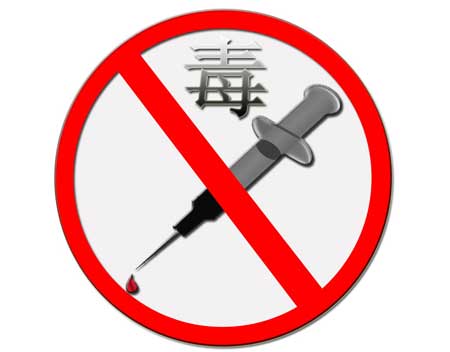
|
Drugs smuggled from abroad, including Southeast Asia and some Central and South Asiancountries, are the main sources of underground drug use across China, according to a senioranti-drug official from the Ministry of Public Security. "Despite great efforts in combating cross-border drug trafficking, we're still facing a grimsituation in the fight against drugs from abroad," Liu Yuejin, director of the ministry's narcoticsdepartment, said in an exclusive interview. Figures from the ministry show more than 90 percent of heroin and methamphetamine tabletsavailable through China's black market come from Southeast Asia. Last year, police in Yunnan province seized 5.37 metric tons of heroin - 73 percent of the totalnationwide - and 8.95 tons of methamphetamine (55 percent of the nationwide total), smuggledover the border with Myanmar. Cases of drug smuggling have also risen sharply on the border between China and Vietnam. Authorities in the Guangxi Zhuang autonomous region uncovered 3,224 cases last year,seizing 415 kg of heroin, up 100 percent from 2011. Liu said China borders two major sources of drugs - the Golden Triangle (comprising parts ofThailand, Laos and Myanmar) and the Golden Crescent, made up of parts of Central andSouth Asia. Opium poppy planting in the Golden Triangle covered about 40,000 hectares last year,producing more than 60 tons of heroin, according to the ministry. Liu said there has been rampant smuggling of synthetic drugs in China from Southeast Asia,including Myanmar, northern Laos and Vietnam, through border areas between Yunnan andGuangxi. Poppy planting in Afghanistan, Pakistan and Iran has reached a total of 154,000 hectares,which can produce more than 370 tons of heroin. "A large quantity of heroin produced in these areas is usually smuggled to the Xinjiang Uygurautonomous region, and transferred to Southeast Asian countries, such as Malaysia andVietnam, and then into Guangdong province by plane ," Liu said. Drugs: Cross-border judicial communication needed Recently, drug traffickers have tried to use shipments of marble, carpets and even Buddhastatuettes to transport drugs as well as more traditional methods, such as the human body,bags or cars, said Yang Zhaohui, another senior official with the ministry's narcoticsdepartment. "Suspects tend to become violent, and even use weapons to fight us at checkpoints," Yangsaid. Cross-border traffickers often use high-tech methods, including wiretapping and networkcontrolling, in remote areas to counter police investigations and avoid punishment, Yang said. "Gang members form a strict management, and assume different tasks, including arrangingdrug sources, hiring traffickers, modifying vehicles, transport and sales," he said. To tackle the problem, China has established judicial cooperation with Southeast Asiancountries, including Myanmar, Laos, Thailand and Malaysia, Liu said. He added that China ispromoting law enforcement cooperation with some countries in Central and South Asia,including Pakistan and Afghanistan. China is also trying to deepen judicial cooperation with North American and European countriesto strengthen intelligence exchanges and case cooperation, Liu said. Hong Daode, a law professor from China University of Political Science and Law, said: "Thepriority is to get the clues and relevant intelligence information for drug trafficking crimes." Liu said the authorities face challenges in combating cross-border drug trafficking, as it isdifficult to uncover trafficking networks and capture gang leaders, as well as conductinginvestigations and collecting evidence. "We need to cooperate with judicial authorities in other countries to identify foreign suspects,and liaise on evidence-collecting abroad," he said.
(China Daily) |
近日,公安部禁毒局局长刘跃进在接受《中国日报》独家专访时表示,来自于“金三角”和“金新月”等境外的毒品仍是我国地下毒品消费市场的主要来源。 “尽管我们在打击跨国毒品犯罪上取得了显著成效,但受国际毒情发展的综合影响,我们面临的毒品形势仍然十分严峻、复杂,”他说。 据公安部禁毒局提供的官方数据显示,2012年,我国国内地下毒品消费市场90%以上的海洛因和90%以上的冰毒片剂都源于“金三角”地区。2012年,仅云南就缴获缅北海洛因5.37吨、冰毒片剂8.95吨,分别占全国总量的73.7%和55.6%。 与此同时,中越边境毒品走私活动加剧,去年广西在中越边境查获毒品走私案件3224起,同比翻了一番,缴获海洛因415千克。 刘跃进说,我国毗邻世界两大毒源地-“金三角”和“金新月”,2012年,“金三角”地区的罂粟种植面积达60万亩,可生产海洛因60多吨。 “‘金三角’地区的合成毒品走私问题也愈演愈烈,主要通过云南、广西等地向我国走私活动猖獗,”他说。 据他介绍,“金新月”地区的罂粟种植面积达231万亩,可生产海洛因370多吨。“该地区海洛因通过马来西亚、越南等东南亚国家,经航空向广东等地‘点对点’渗透,经陆路从广西入境,渠道增多,规模增大,危害加重。” 刘跃进说,近来跨境贩毒案件呈现一些新的特点,藏毒方式不断翻新。贩毒分子在运输毒品过程中除了常见的人体藏毒、箱包藏毒、汽车藏毒、货物夹藏等手段外,还想方设法利用大理石藏毒、地毯藏毒、佛像藏毒等多种方式夹藏运输毒品。 并且,境外毒品通过海陆空邮多渠道向我国进行立体渗透。特别是近年来,境外毒贩雇佣马仔采用人体藏毒方式,直接从境外乘坐飞机点对点对我国进行毒品贩运活动,躲避我国设立的堵源截流网络。同时,跨国贩毒团伙还利用当前日益发展的物流快递渠道,将毒品从境外“点对点”地贩运至内地城市,大大增加了对毒品堵截的压力。 他说,在跨国贩毒案件中,毒贩武装对抗性强,暴力抗法现象屡屡出现,持枪拒捕、武装对抗查缉的案件时有发生。据公安部禁毒局提供的数据显示,自1月份以来,各地在破获毒品案件中共收缴各类枪支739支,子弹2.9万发。 再有,他说,跨国贩毒团伙在实施犯罪活动过程中,不断采用窃听、定位、网络遥控等多种高科技手段进行反侦察,逃避打击,使公安机关查缉毒品的难度不断加大。 “跨国贩毒团伙组织内部分工明确,联系上家,组织货源、雇佣马仔、改装车辆、运输毒品、销售毒品等各个环节均有专人负责,具有很强的反侦察能力,”他说。 刘跃进说,为了应对国际毒情带来的新情况和打击猖獗的毒品跨境走私问题,中国积极参与国际禁毒执法合作,特别是充分利用联合国、东亚次区域以及上海合作组织等多边平台,在共同打击跨境毒品犯罪案件方面、深化国际和区域禁毒执法合作,取得了显著效果。 我国积极巩固和发展与老挝、缅甸、越南、泰国、柬埔寨、印尼、马来西亚等东南亚国家的双边合作,稳步推进与俄罗斯及吉尔吉斯斯坦、哈萨克斯坦和塔吉克斯坦、阿富汗、巴基斯坦等中亚、南亚有关国家的合作。 同时,努力深化与美国、加拿大、德国、英国、澳大利亚等有关重点国家的禁毒情报交流和个案合作,与相关国家联合侦办多起特大跨国走私贩毒案件,提高了跨国跨地区执法合作能力,他说。 为了有效整治湄公河流域突出的毒品犯罪问题,从今年4月20日至6月20日,中国、老挝、缅甸和泰国等四国执法部门集中开展湄公河流域“平安航道”联合扫毒行动,以该流域主要贩运通道为重点,堵截查控毒品和易制毒化学品,摧毁“金三角”毒品在该流域的运输网络,遏制毒品和易制毒化学品走私贩运。 行动启动至今,四国警方共同破获了一批有影响的跨国、跨区域毒品大案要案,摧毁了一批跨国制贩毒网络和制毒工厂,抓获了一批组织者、策划者和制毒技师,通过倒查来源,堵截易制毒化学品流入缅北,切断制毒产业链,进一步遏制了“金三角”地区毒品来源。 在本次行动中,中国和老挝警方于3月19日联合侦破了一起在湄公河水域贩运毒品的特大跨国走私毒品案件,当场从该船甲板夹层内查获冰毒579.7千克,抓获了涉案的5名跨国贩毒犯罪嫌疑人。 刘跃进说道,跨境贩毒案件也给公安机关的侦查和打击带来诸多挑战和现实困难。一方面,跨境贩毒网络发现难和幕后组织者抓捕难。跨境贩毒案件的幕后组织者一般都身处境外遥控指挥,受国家间的不同司法体制和国家间引渡、移交等条件制约,实际认定、追踪、抓捕及移交幕后毒枭的周期较长,难度较大。 另一方面,打击跨境毒品犯罪取证难。在打击跨境毒品犯罪时,对外籍犯罪嫌疑人的身份确认,对涉及境外的毒品犯罪行为证据收集与固定,都需要相关国家警方的协作与配合,由于相关国家间的司法体制不同,法庭证据要求不同,打击跨境毒品的取证难度相对较大。 (中国日报记者张琰编译)
|
|
|